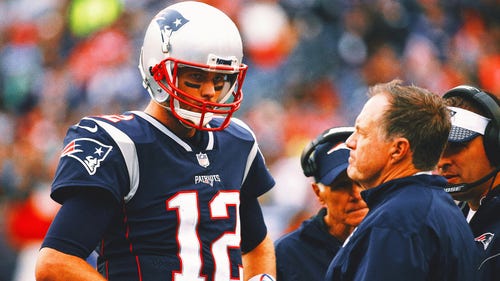
'Drew could have died': The lasting lessons of the hit that launched Tom Brady
Fifteen years ago Friday, on Sept. 23, 2001, with 5:03 remaining in the fourth quarter of the Jets-Patriots game, Jets linebacker Mo Lewis slammed into Patriots quarterback Drew Bledsoe along the right sideline at old Foxboro Stadium.
That moment changed the NFL forever.
Bledsoe returned for a series, threw one more pass, and then was replaced by unknown backup Tom Brady. Everybody knows the rest of the story. Bledsoe never got his job back as Brady led the Patriots to their first of four Super Bowl titles and has evolved into arguably the best NFL quarterback ever.
Bledsoe was traded to the Bills in the off-season, made the Pro Bowl in 2002, and then finished his career with two seasons in Dallas. Now 44, he runs the Doubleback winery with his wife, Maura, in his hometown of Walla Walla, Wash.
Lewis, an All-Pro in 1998 and a member of the Jets’ All-Time Four Decade Team, retired after the 2003 season and lives in Alpharetta, Ga., with wife, Christalyn. Their impressive two sons, Mo IV and Chris, are playing basketball at the Naval Academy and Harvard, respectively.
The famous blow, which occurred on a warm and humid night when the Patriots honored the victims and first responders to the Sept. 11 terrorist attacks in their first home game, certainly altered NFL history. It also served as a valuable lesson for the sports medicine community.
Dr. Thomas Gill IV, who was a Patriots team physician in 2001 and went on to serve as the team doctor from ’06 to ’14, is an internationally recognized leader in sports medicine and has taught and lectured at Harvard Medical School and Massachusetts General Hospital. He continues to work closely with a half dozen, hand-chosen residents and fellows each year, and lectures around the country.
In almost every one of his lectures, Gill includes a picture of Lewis’s hit on Bledsoe.
“That play probably taught more generations of medical students, residents and sports medicine specialists to think outside the box a little bit and not jump to conclusions,” says Gill. “So much of what we do is repetition. A guy takes that hit and you’re like, ‘Of course, this is the likely injury.’ But I always say, ‘What else could this be that could be dangerous?’
“I always show that hit. There’s an old saying when we learn about the phrenic nerve, which is a nerve that aerates your diaphragm and allows you to breathe, in med school. It’s called ‘C3, 4, 5 and keeps the diaphragm alive.’ And the reason you remember that is C3 is the nerve that goes to the top of the shoulder. And so a lot of times if you have blood or fluid in your chest, it irritates your diaphragm, it irritates the nerve, so the presenting symptom of a serious chest condition can be shoulder pain. So it’s kind of my way of saying, just because an athlete or a patient comes to you with shoulder pain, think ‘What else could this be that I could be missing?’ before jumping to the obvious diagnosis.”
That’s how it happened with Bledsoe’s injury, which was thought to be so typical that he went back into the game for a series. After that, he was removed and sent to the locker room under the care of Patriots team physician Dr. Bertram Zarins, and Gill.
“I shouldn’t have put him out there,” Patriots coach Bill Belichick said in his postgame press conference. “Watching him play, he wasn’t himself. He got his bell rung. When I went over to him he seemed coherent and said he was O.K. But after watching him I didn’t think he was. I told him what decision I had made. He understood.”
Gill remembers the incident like “it was yesterday.”
“I can’t believe it’s been 15 years,” says Gill, who also went on to serve as the team doctor for the Red Sox and Bruins. “It was such a seminal moment in taking care of teams for as long as I’ve been taking care of teams. It was the closest to losing an athlete that I had ever been.”
And it didn’t start out that way on the Patriots’ bench.
“He just couldn't get comfortable, so I took him into the locker room,” says Gill. “Drew’s a very laid back guy. And he was just not himself. Even in kind of the wildest game situations, he was always kind of laid back. I remember him being in the locker room and being really agitated. And his brother [Adam] came in to see what had happened. And he was like, ‘Come on, let’s get you out of here, let’s get you home. I don’t want the media seeing you, I don’t want people taking pictures of you hurt. Let’s get you out before too many people start bugging you about what’s wrong.’
“Drew starts to pack up and get ready but he just wasn’t himself. He kept saying, ‘My shoulder hurts, my shoulder hurts.’ I said, ‘Wait a minute, let’s just settle down and figure out what’s going on.’
“I started examining him and it was pretty clear to me that his shoulder was not the main issue. I actually thought he may have had an abdominal injury or ruptured his spleen and I called our internist over, Jim Dineen, to look at him as well. I said, ‘I think something’s going on with his abdomen. Could be his chest, but I think it’s probably a ruptured spleen.’ Our internist looked at him and said, ‘Yeah, I agree. There’s something going on here.’ Then we took his vital signs and his pulse was high, and he was breathing kind of rapidly. We got the ambulance in, we told his brother to step out for a second. We put him into the ambulance for Mass General.”
At that point, Gill called a colleague and former Harvard classmate, David Berger, at home. This wasn’t a “Hey, what did you think of the game?” chat between old college buddies.
“I said, ‘Can you meet Drew over at MGH emergency room? I think something bad happened, like he ruptured his spleen. But can you take a look at him?’ And he said, ‘Sure,’” says Gill.
Bledsoe had suffered a hemothorax, and his abdomen was filling with blood.
“Drew could have died,” says Gill. “He ended up having about three liters of blood in his chest. He had torn one of the blood vessels behind his rib that was then pumping blood into his chest. They got a CAT scan of his belly, and you can see the bottom of the lung fields and they could see that was filled with fluid. So then they extended the study up the chest and saw what the problem was. They were able to drain the blood out and immediately once that happened, he started feeling better, his breathing was under control, his blood pressure stabilized. But it was really dicey. I don't even think Drew knows how serious it was. But he really could have died.”
Bledsoe was cleared to return on Nov. 13.
“I think this was a very unusual injury,” Berger said after allowing Bledsoe to return to practice. “I don’t think we’ve ever seen an injury like this in a professional athlete.”
Fifteen years later, the hit lives on, in the NFL and sports medicine.
This article originally appeared on



